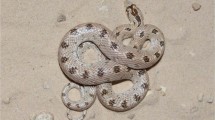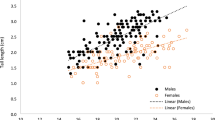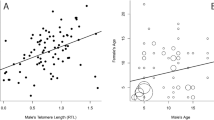Abstract
Darwin's1 hypothesis that male secondary sexual ornaments evolve through female preferences is theoretically plausible2–7, but there is little experimental field evidence that such preferences exist8–10. I have studied female choice in relation to male tail length in the long-tailed widowbird, Euplectes progne, and report here that males in which the tail was experimentally elongated showed higher mating success than males having normal or reduced tails. The possibility that intrasexual competition among males maintains the long tail was not supported: males with shortened tails held their territories as long as did other males. These results suggest that the extreme tail length in male long-tailed widowbirds is maintained by female mating preferences.
This is a preview of subscription content, access via your institution
Access options
Subscribe to this journal
Receive 51 print issues and online access
$199.00 per year
only $3.90 per issue
Buy this article
- Purchase on Springer Link
- Instant access to full article PDF
Prices may be subject to local taxes which are calculated during checkout
Similar content being viewed by others
References
Darwin, C. The Descent of Man, and Selection in Relation to Sex (John Murray, London, 1871).
Fisher, R. A. The Genetical Theory of Natural Selection (Clarendon, Oxford, 1930).
Maynard Smith, J. in A Century of Darwin (ed. Barnett, S. A.) 231–245 (Heineman, London, 1958).
O'Donald, P. Theor. Populat. Biol. 12, 298–334 (1977).
O'Donald, P. Genetic Models of Sexual Selection (Cambridge University Press, 1980).
Lande, R. Proc. natn. Acad. Sci. U.S.A. 79, 3721–3725 (1981).
Kirkpatrick, M. Evolution 36, 1–12 (1982).
Halliday, T. R. in Behavioural Ecology, An Evolutionary Approach (eds Krebs, J. R. & Davies, N. B.) 180–213 (Blackwell, Oxford, 1978).
Andersson, M. Biol. J. Linn. Soc. 17, 375–393 (1982).
Searcy, W. A. A. Rev. Ecol. Syst. 13 (in the press).
Craig, A. J. F. K. J. Orn. 121, 144–161 (1980).
Lack, D. Ibis 77, 817–836 (1935).
Craig, A. J. F. K. Ostrich 45, 149–160 (1974).
Orians, G. H. Am. Nat. 103, 589–603 (1969).
Staddon, J. E. R. Am. Nat. 109, 541–545 (1975).
Parker, G. A. in Current Problems in Sociobiology (Cambridge University Press, in the press).
Borgia, G. in Sexual Selection and Reproductive Competition in Insects (eds Blum, M. S. & Blum, N. A.) 19–80 (Academic, New York, 1979).
Bradley, J. V. Distribution-free Statistical Tests (Prentice-Hall, Englewood Cliffs, 1968).
Author information
Authors and Affiliations
Rights and permissions
About this article
Cite this article
Andersson, M. Female choice selects for extreme tail length in a widowbird. Nature 299, 818–820 (1982). https://doi.org/10.1038/299818a0
Received:
Accepted:
Issue Date:
DOI: https://doi.org/10.1038/299818a0
This article is cited by
-
The roles of sexual selection and sexual conflict in shaping patterns of genome and transcriptome variation
Nature Ecology & Evolution (2023)
-
Male color polymorphism in populations of reef geckos (Sphaerodactylus notatus) reduces the utility of visual signals in sex recognition
Behavioral Ecology and Sociobiology (2023)
-
Aggressive behaviour in the skyhoppers of the Australian Alps
Evolutionary Ecology (2022)
-
Commentary: The ecological and evolutionary implications of allometry
Evolutionary Ecology (2022)
-
Male genital lobe morphology affects the chance to copulate in Drosophila pachea
BMC Ecology and Evolution (2021)
Comments
By submitting a comment you agree to abide by our Terms and Community Guidelines. If you find something abusive or that does not comply with our terms or guidelines please flag it as inappropriate.



